Artificial intelligence (AI) can be leveraged by marketers to optimize social media content and campaigns. The technology is now integrated into the key social media platforms to enhance features and help shape activities at scale.
In fact, 97% of business leaders believe that AI helps optimize social media data and insights more effectively to improve marketing efforts, according to The 2023 State of Social Media Report.
In this blog, we will explore the world of social media and AI and cover:
- What is AI in Social Media?
- Examples of How to Use AI in Social Media?
- What are the Best AI Social Media Tools?
- 4 Examples of Brands Using AI in Social Media
The Pros and Cons of AI in Digital Marketing
Download Free!What is AI in Social Media?
AI in social media marketing is the use of advanced technologies, such as machine learning and natural language processing, to analyze user data and interactions on social platforms.
This means marketers can use AI tools for content creation, social media listening, brand awareness, ad targeting and management along with influencer research. This enables data-driven decision-making that can shape a social media strategy.
The ideal situation for any consumer of social media is that they find their feed filled with content that is relevant and useful - including ads. That’s what AI has the potential to do for digital marketing through hyper-personalization.
Examples of How to Use AI in Social Media
The scope of using AI in social media is huge. The technology has the potential to improve and optimize many marketing tasks such as:
- Personalization
- Content generation
- Influencer marketing
- Customer service
- Advertising
Let’s look at each one in more detail.
1. Content generation
AI tools are transforming content generation. The best known of these is ChatGPT but others such as Claude and Jasper could catch up with some great features for marketers such as the former’s ‘vision capabilities’ and Jasper’s new metrics suite.
Content generation can be time-consuming for companies whether it’s posts for social media campaigns or long-form content like blogs, particularly when there’s no in-house copywriter or content marketer.
By using ChatGPT prompts, marketers can create content based on key factors such as keywords, target audience, digital channels, tone of voice, and even brand voice to create social posts, articles, voiceover scripts, videos, and images.
2. Influencer marketing
As traditional advertising finds it increasingly difficult to reach today's ad-fatigued customers, the right influencer can provide an effective way to connect with a target audience.
Influencer marketing is not just about celebrities or wealthy content creators, it’s about reaching your niche audience by partnering with someone who has their trust and respect.
Using AI in influencer marketing can help you identify influencers that your target audience follows along with identifying fraudulent influencers. These tools can also evaluate an influencer’s level of engagement and content style along with monitoring performance and assessing ROI.
Luxury brand Balmain went one step further in its influencer marketing by casting virtual models. The campaign featured three models: Shudu, Margot, and Zhi. Shudu has 240,000 Instagram followers with a claim to being the world’s first virtual supermodel.
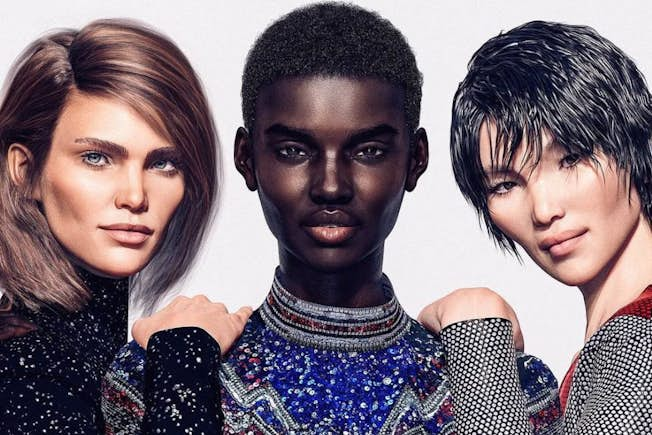
3. Personalization
AI can analyze user behavior and preferences. This allows marketers to deliver tailored content that appeals and is relevant to their target audience.
A great example of this on social media is TikTok. Its algorithm is so successful in finding and recommending relevant content, that it’s more or less becoming a search engine.
People no longer use TikTok to just watch videos or follow influencers, they use it to conduct searches that would otherwise be conducted on Google.
You can use AI automation to optimize posting times on social channels based on past performance. Through analysis on automation tools you can gain better insights on the KPIs related to each marketing campaign in real time to track performance to help inform you social media outputs.
You can also leverage social listening for personalization. It can be used to identify relevant topics, trending or popular keywords and monitor the conversations of consumers across social media - good and bad.
For example, Sprout Social’s sentiment analysis allows marketers to analyze messages and customer sentiment toward your brand keywords - positive, negative or neutral. This can reveal areas where customers need more customized support.
4. Customer service
Social media has become a customer service channel. People want answers or issues resolved quickly and so they flock to social media to reach out to brands.
Due to this demand, social channels have turned to AI-powered chatbots and virtual assistants.
Meta uses chatbots in its platforms Facebook Messenger and WhatsApp and these? can also be programmed to understand questions, provide answers, and carry out tasks. These AI tools can also provide a customized online shopping experience and even make sales.
Snapchat has also launched a chatbot - My AI. It aims to act like a friend (due to its younger demographic) to “answer a burning trivia question, offer advice on the perfect gift for your BFF’s birthday, or suggest what to make for dinner”. It has come under fire - see this article from the Washington Post - for inappropriate content so it’s important to remember some of these tools are in the testing stage and are generative so they need to keep learning!
An example is Coca-Cola’s chatbot launched as an ad on Instagram’s newsfeed. The aim is to connect people to local restaurants for the “perfect meal” via direct messaging. Once a person finds the right place, they can go to OpenTable’s app or site to make a reservation.
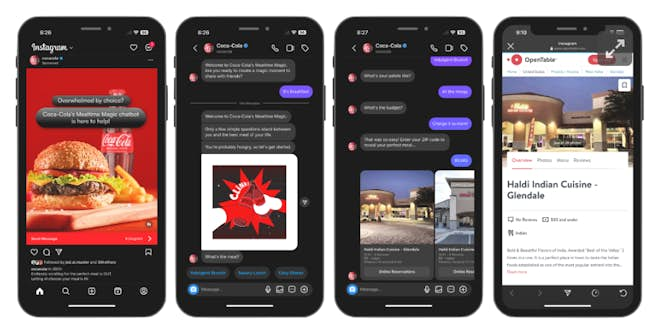
5. Advertising
With so much noise online, it can be hard to get a good ROI for advertising campaigns. Savvy companies are now leveraging AI to deliver more relevant, engaging, and effective marketing campaigns while optimizing resources and driving business growth.
What can AI tools do for advertising?
- Analyze targeting and budget variations
- Find and segment audiences
- Manage ad campaigns
- Generate and optimize ad content
- Conduct A/B testing
- Predictive analytics
For example, lingerie retailer Cosabella replaced its digital agency with an AI platform named ‘Albert’. Based on the company’s KPIs, parameters, and content, Albert identified emerging user behavior and patterns across paid search and social media. Insights and suggestions were then provided for optimal performance and scalability.

As a result, the company increased its search and social media return-on-ad-spend by 336% and increased social sales by 20x.
“After seeing Albert (AI) handle our paid search and social media marketing, I would never have a human do this again. ” Courtney Connell, Marketing Director of Cosabella
What are the Best Tools For AI in Social Media?
The great thing about social media is that there’s a range of platforms and content types to choose from. But that’s also the downside!
It can take a lot of time and resources to manage social media for a business - particularly if a company is active across several networks. That’s where AI tools for social media can help.
The tools’ usefulness lies in their ability to streamline social media management processes, enhance marketing strategies, and improve customer engagement.
You can also use AI to sift through huge volumes of content (e.g. user-generated and competitor content) to see what resonates with your audience and identify emerging trends.
When we asked our followers on LinkedIn which tools they found the most useful this was the result.
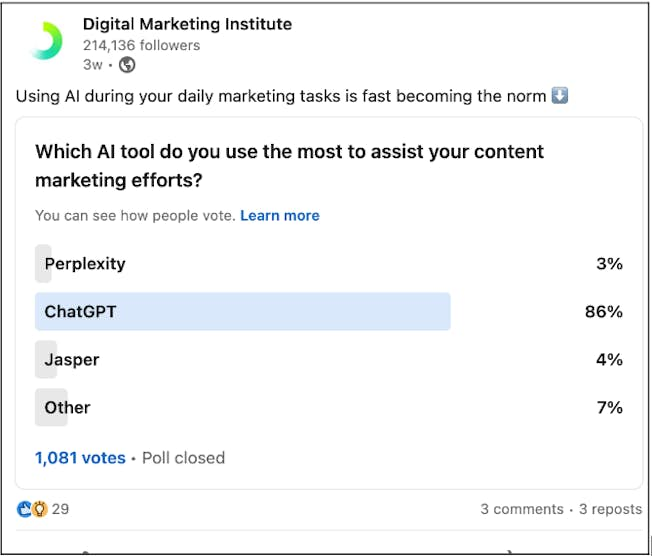
Here are some of the most effective AI tools for social media out there:
- ChatGPT is a generative AI tool capable of creating human-like text responses across a wide variety of topics.
- Midjourney and DALL-E are generative AI tools for creating AI images from prompts.
- Brandwatch uses AI to monitor and analyze conversations on social media and the web.
- Sprout Social is a social media management platform that helps schedule posts, engage with audiences, and analyze metrics.
- AdEspresso is an advertising platform focused on optimizing and managing social media ad campaigns for better performance.
- Chatfuel enables businesses to create and deploy chatbots on messaging platforms such as Facebook Messenger to automate customer interactions and marketing.
- Upfluence is an influencer marketing platform that helps businesses identify, connect with, and analyze influencers.
- CapCut is a free online video editor for a desktop powered by AI that allows you to create high-quality videos.
- Grammarly is an AI writing assistant that helps users improve grammar, punctuation, style, and tone in their written content.
- Canva uses AI to help create unique images, art, and video with the Magic Media feature.
- Whimsical Diagrams custom GPT in ChatGPT: Mind mapping for social media planning that can visualize your plan for a campaign in seconds.
- Ubersuggest Chrome Plugin: Gives search volume and CPC on webpages as you search on Google.
- Answer The Public: Provides the most asked questions on the most popular search engines; Google, YouTube, TikTok, Amazon, and Bing.
- ManyChat Meta automation of Instagram DMs, Facebook Messenger and WhatsApp allows you to set up keywords in social post captions that activate automated replies in the comments, and DMs.
There are also some great AI tools for competitive research such as TikTok Creative Center with Creative Assistant and Meta Ads Library with Meta Brand Partnership Library if you want to find out what the competition is up to!
4 Examples of Brands Using AI in Social Media
To show you how AI can be used in practice in social media, here are some great examples from brands big and small.
1. Heinz A.I Ketchup
With new artificial intelligence text-to-image programs taking over the internet, the brains behind Heinz ketchup wanted to find out what AI thought ‘ketchup’ looked like.
To do this they used AI-powered Dall-E 2 to generate images of ketchup by using prompts such as “ketchup scuba diving” or “ketchup in outer space”. The result? The company found that many results looked just like bottles of Heinz.
Heinz fans got involved by posting suggestions for image prompts. The best ones were turned into social posts and print ads meaning that the company created the first-ever ad campaign with visuals generated entirely by AI.
2. Ryan Reynolds & Mint Mobile
Ryan Reynolds is renowned for his deadpan humor (just look at his other venture with Aviation American Gin to see more) as a way to promote and engage.
With AI causing such a buzz in the public domain (and as a way to save customers money), he turned to ChatGPT and gave it prompts to develop a script for a commercial in his voice.
Reynolds asked ChatGPT to include:
- A joke
- A curse word
- The holiday promo is ongoing even though the other wireless companies have ended theirs
This ad on YouTube is the result and it’s not bad!
3. Sephora & Ora
Sephora is known for using AI to bring customers on a beauty journey. It was one of the first beauty brands to embrace the interactive nature of chatbots in 2016 which has seen huge success for the brand.
Using Facebook and Messenger, Sephora launched chatbot ‘Ora’ aimed at millennials in France. Available 24/7, the chatbot can answer a wide variety of questions about frequent shopper points, order tracking, product availability, and more.
It can also suggest personalized content such as news stories, trends or even beauty coaching through tutorial videos and tips.
An extensive research process went into developing the app which you can see here. Here’s a screenshot of the mobile user interface.
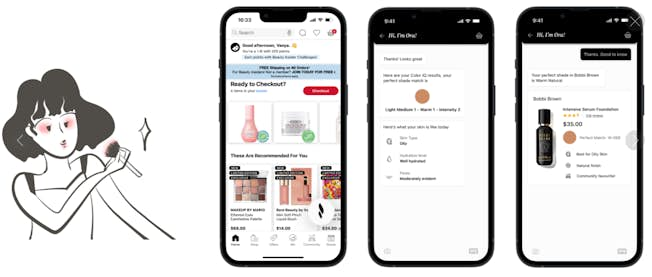
4. Ray-Ban & Meta
Ray-Ban has developed smart glasses that use Meta’s AI virtual assistant technology to see and hear!
This means anyone wearing them should be able to access Meta’s AI assistant to see and hear through the camera and microphones of the glasses. Users can also translate text and see image captions.
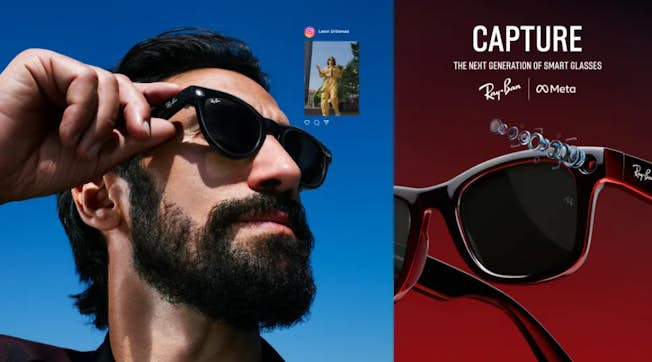
Meta also plans to roll out the ability for the glasses to retrieve real-time information using AI and powered in part by Bing. This means wearers will be able to get answers about sports scores, information on local landmarks or even stocks.
Conclusion: Social Media & AI
There’s no doubt that AI is changing digital marketing.
The AI market in social media is expected to reach $3.7 million by 2026 according to Mordor Intelligence. This growth is driven by the increased integration of AI with social media for advertising and companies wanting to gain a competitive edge.
With so many ways to use AI in social media marketing, it can be overwhelming. That's where AI skills and knowledge come in. Experimenting with AI tools and platforms can help you see what you can do with your social media, whether that’s generating and optimizing social content, conducting social listening or automating advertising on platforms.
It’s also about leveraging AI to get data-driven insights that can help you get under a customer’s skin to deliver the content they need, when they need it.
Optimize and scale your social media marketing with AI
Social media is a successful way to connect, influence and convert customers and AI is making it even easier to personalize and optimize campaigns. But it’s all about how you use it! Our AI in Digital Marketing course will not only teach you the fundamentals of AI but also help you to understand and implement AI data-driven marketing, get to grips with key AI tools like ChatGPT and Stability AI, and explore AI ethics. Get started today!
Related
Upgrade to Power Membership to continue
your access to thousands of articles, toolkits, podcasts, lessons and much much more.
Become a Power Member- Login
- View Courses
- - - -
- Courses
- Resources
- - - -
- My Account
- Change Password
- Logout






